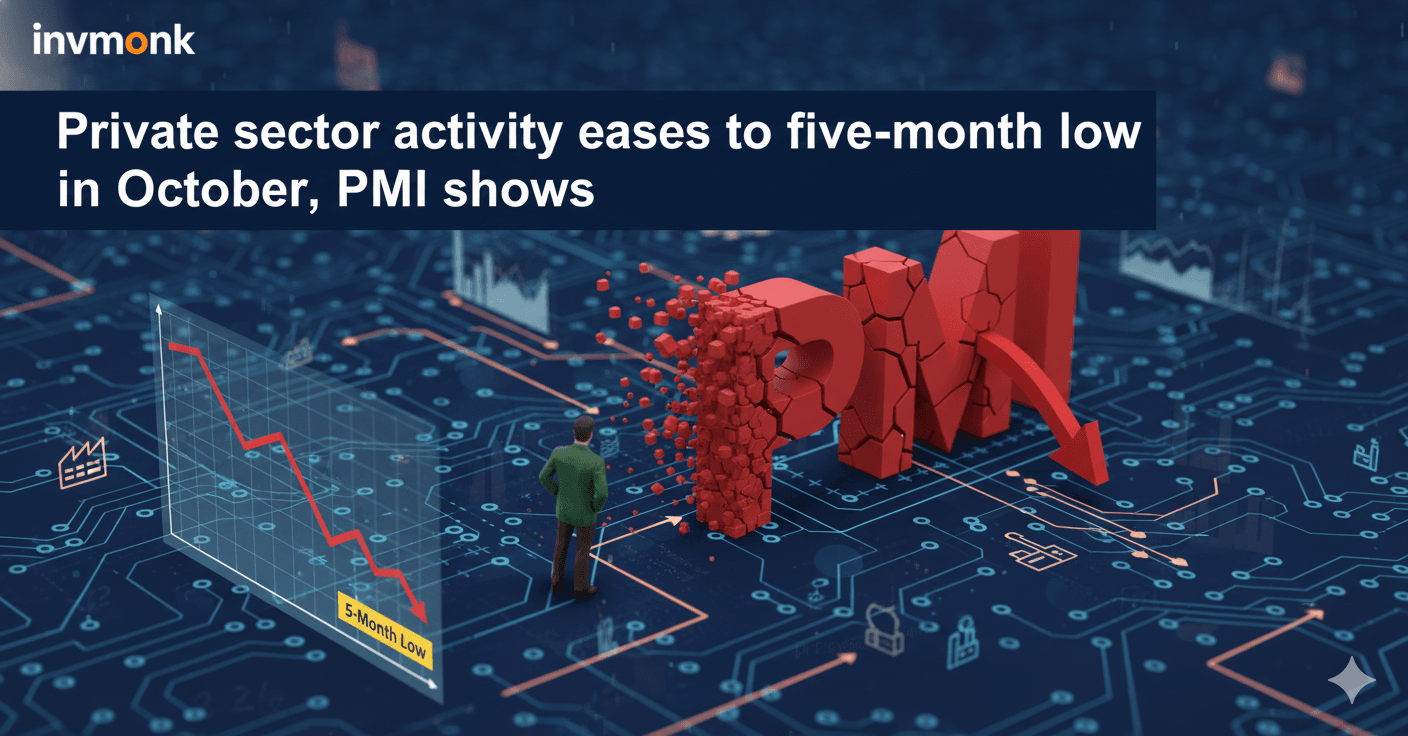In a concerning signal for one of the world’s fastest-growing economies, India’s private sector activity cooled to its weakest pace in five months during October 2025. The HSBC Flash India Composite Purchasing Managers’ Index (PMI), compiled by S&P Global, dipped to 59.9 from 61.0 in September—falling short of economists’ expectations of 61.2. While still firmly in expansion territory above the 50 no-change mark, this India PMI October 2025 reading underscores mounting pressures from softer demand, rising costs, and escalating US tariffs on India. As President Donald Trump doubles down on trade barriers unless India curbs Russian oil imports, businesses are bracing for a tougher road ahead.
If you’re monitoring the India economy 2025 or wondering how global trade tensions are rippling through emerging markets, this breakdown unpacks the data, sector insights, and what it means for growth. Drawing from the latest Reuters analysis, here’s the full picture.
What Drove the October PMI Slowdown? Key Factors at Play
The composite PMI tracks month-on-month changes in output across manufacturing and services, India’s economic heavyweights. October’s slip reflects a broader softening in business conditions, with new orders expanding at their slowest clip since May and international demand hitting a seven-month low.
- Weaker Domestic and Global Demand: Firms reported subdued client spending, dragging on overall momentum. This comes amid a post-monsoon slowdown and lingering effects from earlier inflationary spikes.
- Rising Output Prices: Despite some relief from a recent goods and services tax (GST) cut in September, companies hiked selling prices to counter operational costs—eroding customer affordability and business confidence.
- Business Optimism Wanes: Future sales expectations dipped, fueled by intensifying competition, volatile market conditions, and uncertain demand trends.
Compiled monthly, the PMI is a leading indicator of economic health, often foreshadowing GDP shifts. At 59.9, it signals robust but decelerating growth—potentially trimming India’s FY26 GDP forecast if pressures persist.
Sector Spotlight: Services Stumble While Manufacturing Edges Up
India’s private sector is a dual-engine economy, and October’s data revealed stark divergences:
| Sector | October PMI | September PMI | Key Insight |
|---|---|---|---|
| Composite (Overall) | 59.9 | 61.0 | Five-month low; below forecast of 61.2 |
| Manufacturing | 58.4 | 57.7 | Recovery from four-month trough; quicker new orders growth |
| Services | 58.8 | 60.9 | Sharp slowdown; softer domestic and export demand |
- Manufacturing Resilience: Output rose at the fastest pace in five months, buoyed by a rebound in new business and production. Goods producers cited steady domestic orders, though export gains tempered due to global headwinds.
- Services Vulnerability: The sector, which dominates India’s GDP, saw its steepest drop in six months. Consulting, IT, and financial services flagged weaker client pipelines, highlighting sensitivity to both local slowdowns and overseas uncertainties.
This split underscores manufacturing’s role as a buffer, but services’ drag could amplify risks if urban consumption—already strained by high borrowing costs—doesn’t rebound soon.
Trump Tariffs Loom Large: The US-India Trade Flashpoint
No analysis of India’s October PMI is complete without spotlighting geopolitical trade frictions. President Trump’s renewed vow to maintain “massive tariffs” on Indian exports unless New Delhi halts Russian oil purchases has exporters on edge. This rhetoric, echoed in a recent White House statement, targets key sectors like textiles, pharmaceuticals, and gems—vital to India’s $500 billion+ merchandise trade surplus.
- Export Hit Confirmed: A Reserve Bank of India (RBI) bulletin highlighted a sharp September drop in US-bound shipments as tariffs bit harder, with merchandise trade showing resilience elsewhere but vulnerability to America’s protectionism.
- Broader Implications: International new orders in the PMI survey softened notably, with manufacturing exports leading the decline. Analysts warn this could shave 0.2-0.5% off India’s export growth for the quarter if duties escalate further.
For businesses navigating Trump tariffs impact on India, the message is clear: Diversify markets urgently. Opportunities in Europe, ASEAN, and the Middle East could offset US losses, but at the cost of higher logistics and compliance hurdles.
Navigating the Road Ahead: RBI’s Role and Investor Signals
Despite the PMI dip, India’s fundamentals remain solid—buoyed by strong FDI inflows, infrastructure spending, and a youthful workforce. Yet, the RBI faces a delicate balancing act: Cooling inflation (thanks to the GST trim) versus supporting growth amid global volatility.
- Policy Levers: Expect potential rate cuts in December if monsoon harvests boost rural demand. The central bank’s recent report stresses resilience but flags external risks like oil price swings tied to India’s Russia ties.
- Investor Takeaways: Equity markets may see short-term volatility, but long-term bets on digital services and green manufacturing hold appeal. Track November’s final PMI for confirmation of this trend.
Economists like those at HSBC note that while 59.9 signals moderation, not contraction, sustained sub-60 readings could pressure FY26 growth projections from 6.8% to around 6.5%.
Final Thoughts: Can India Accelerate Past These Headwinds?
October’s India private sector PMI paints a picture of an economy pausing for breath amid domestic caution and US trade thunder. With services faltering and tariffs tightening, New Delhi must prioritize export diversification and domestic stimulus to reignite momentum. For global investors, this dip is a buying opportunity in a market still outpacing peers—but vigilance on Washington-Beijing-Delhi dynamics is key.
What’s your view on how India US trade relations will evolve under Trump 2.0? Drop a comment below, and subscribe for updates on Asian economy trends and PMI breakdowns. In uncertain times, staying informed is your edge.

